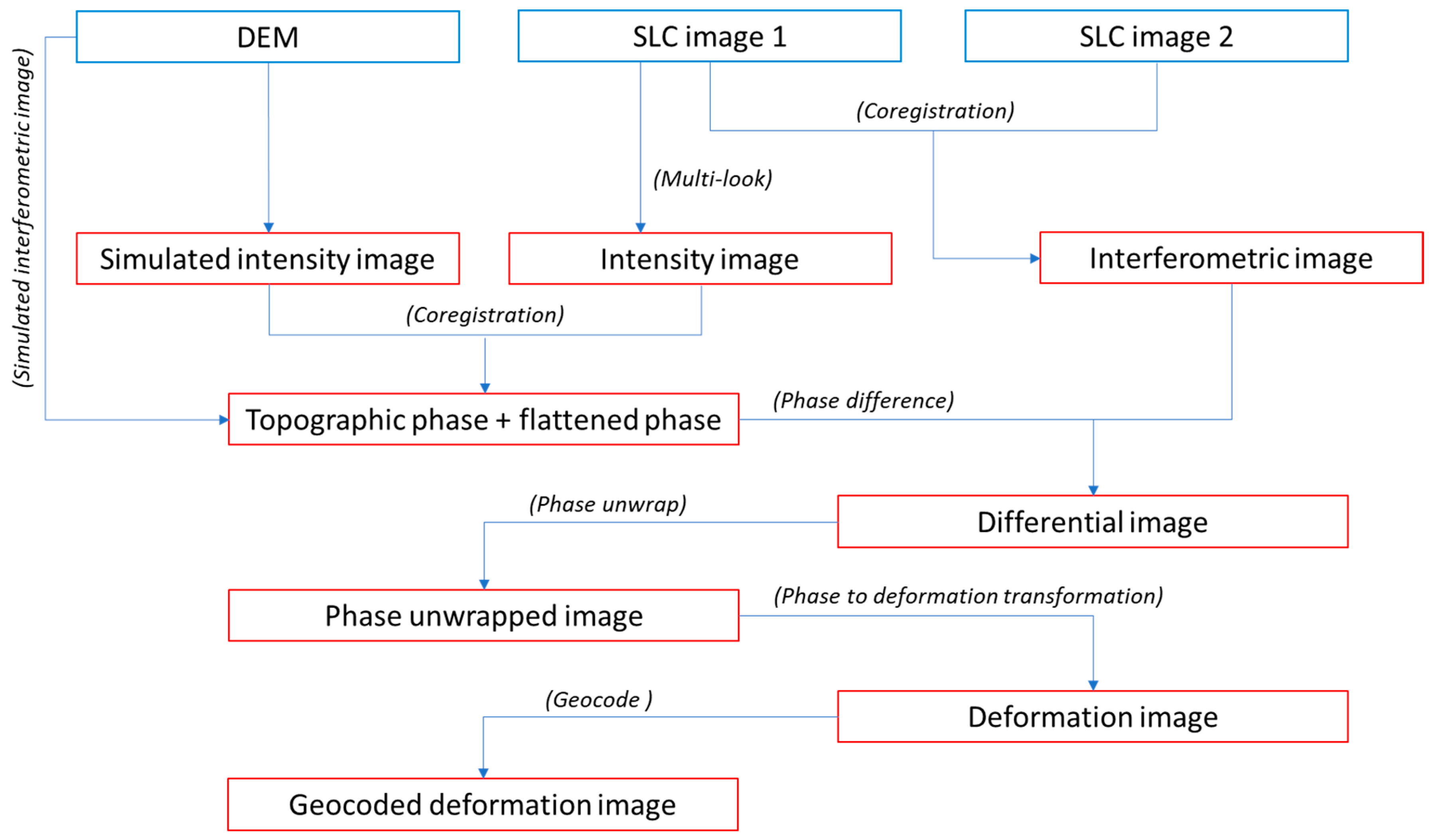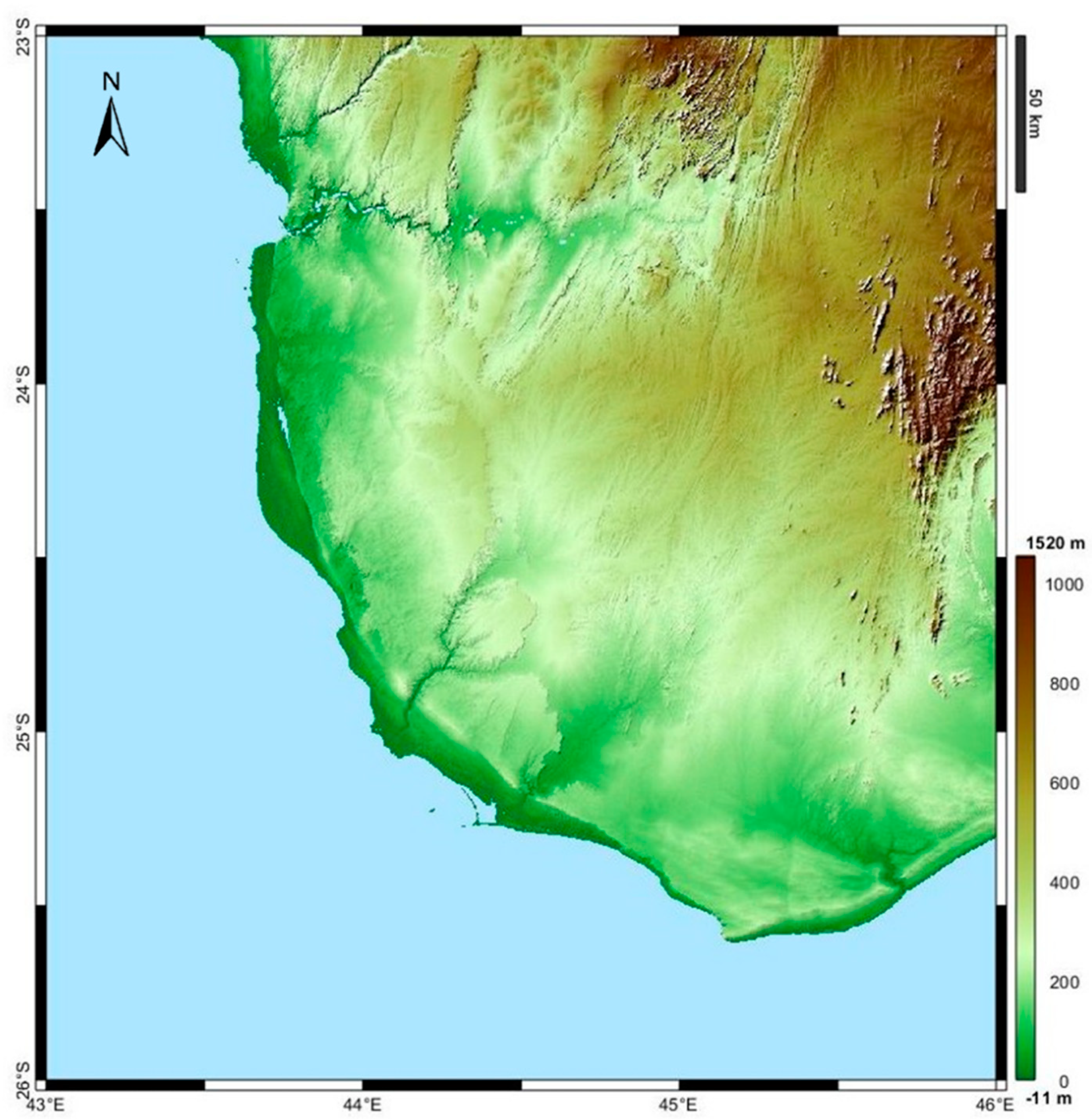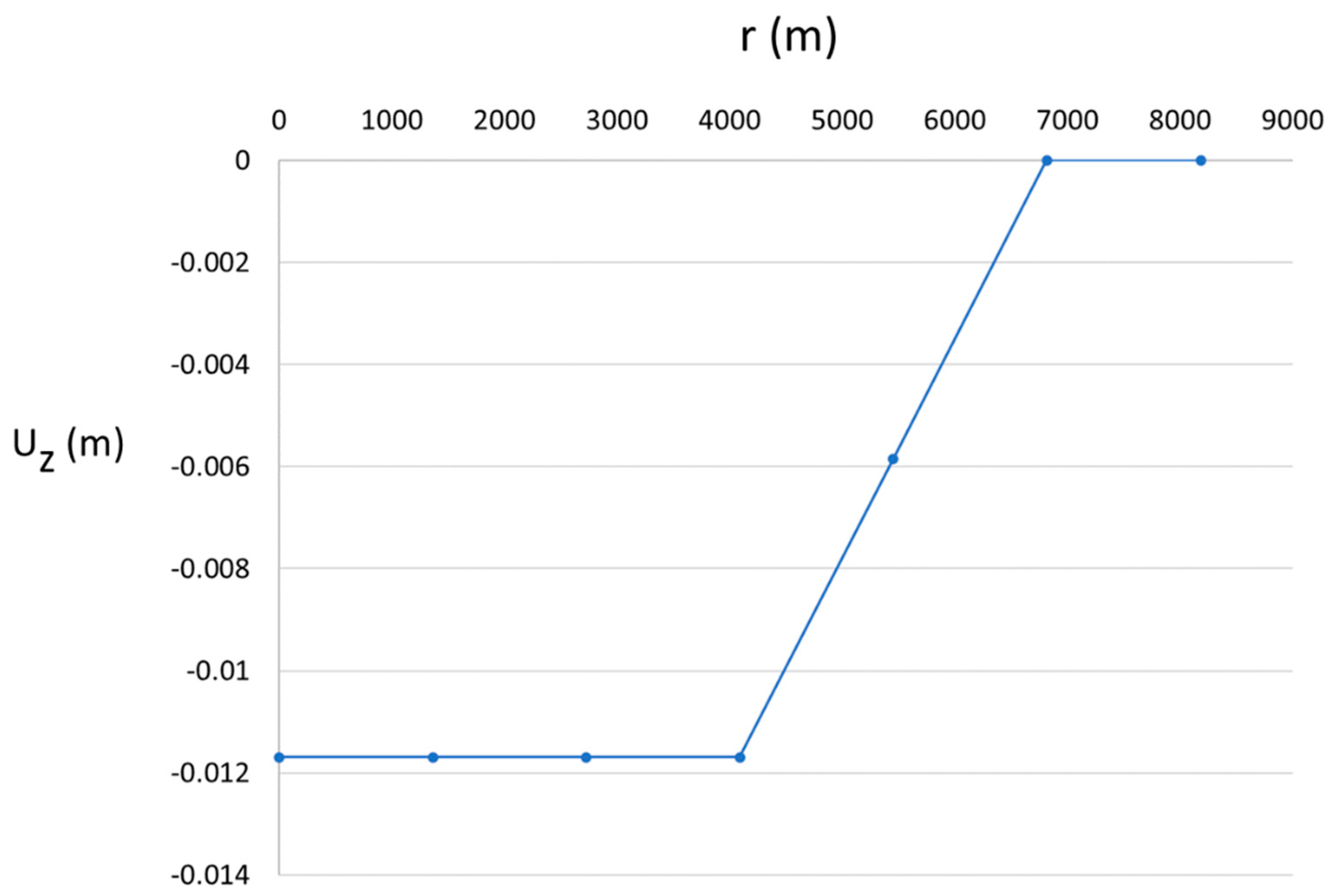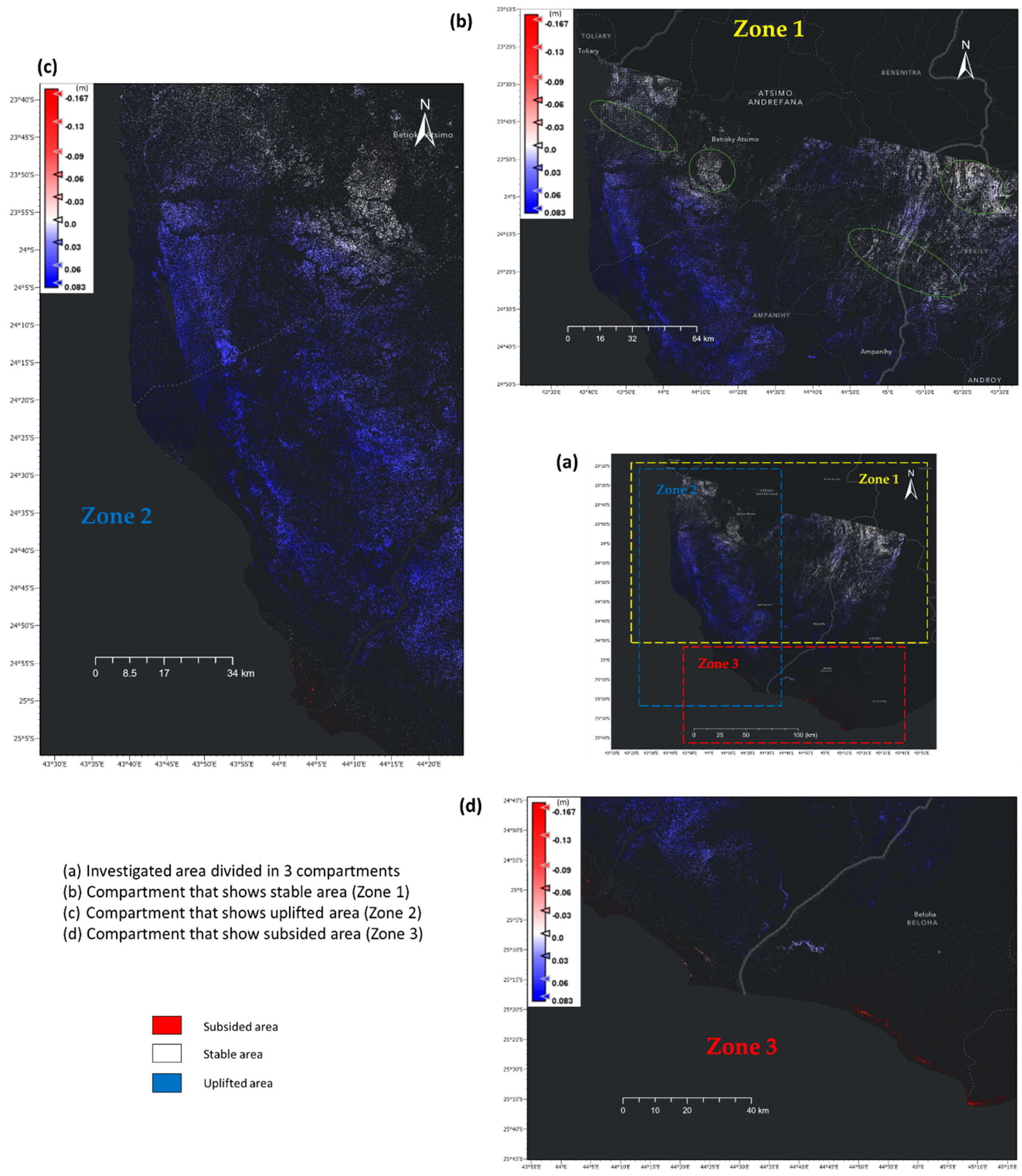Land Subsidence Assessment for Wind Turbine Location in the South-Western Part of Madagascar
Abstract
:1. Introduction
2. Materials and Methods
2.1. Mechanism of Land Subsidence
2.2. Land Deformation Monitoring Using SAR Images
3. Geological Setting
4. Results
5. Discussion
6. Conclusions
Author Contributions
Funding
Institutional Review Board Statement
Informed Consent Statement
Data Availability Statement
Acknowledgments
Conflicts of Interest
References
- Geertsma, J. Land Subsidence above Compacting Oil and Gas Reservoirs. J. Pet. Technol. 1973, 25, 6. [Google Scholar] [CrossRef]
- Holzer, T.L.; Bluntzer, R.L. Land Subsidence Near Oil and Gas Fields, Houston, Texas a. Groundwater 1984, 22, 450–459. [Google Scholar] [CrossRef]
- Calderhead, A.I.; Martel, A.; Alasset, P.-J.; Rivera, A.; Garfias, J. Land Subsidence Induced by Groundwater Pumping, Monitored by D-InSAR and Field Data in the Toluca Valley, Mexico. Can. J. Remote Sens. 2010, 36, 9–23. [Google Scholar] [CrossRef]
- Knez, D.; Zamani, M.A.M. Empirical Formula for Dynamic Biot Coefficient of Sandstone Samples from South-West of Poland. Energies 2021, 14, 5514. [Google Scholar] [CrossRef]
- Knez, D.; Khalilidermani, M. A Review of Different Aspects of Off-Earth Drilling. Energies 2021, 14, 7351. [Google Scholar] [CrossRef]
- Khalilidermani, M.; Knez, D. A Survey of Application of Mechanical Specific Energy in Petroleum and Space Drilling. Energies 2022, 15, 3162. [Google Scholar] [CrossRef]
- Galloway, D.L.; Hudnut, K.W.; Ingebritsen, S.E.; Phillips, S.P.; Peltzer, G.; Rogez, F.; Rosen, P.A. Detection of Aquifer System Compaction and Land Subsidence Using Interferometric Synthetic Aperture Radar, Antelope Valley, Mojave Desert, California. Water Resour. Res. 1998, 34, 2573–2585. [Google Scholar] [CrossRef]
- Whittaker, B.N.; Reddish, D.J. Subsidence: Occurrence, Prediction, and Control; Developments in Geotechnical Engineering; Distributors for the U.S. and Canada; Elsevier Science Pub. Co.: Amsterdam, The Netherlands; New York, NY, USA, 1989; ISBN 978-0-444-87274-6. [Google Scholar]
- Rajaoalison, H.; Knez, D.; Zlotkowski, A. Changes of dynamic mechanical properties of brine-saturated Istebna sandstone under action of temperature and stress. Przem. Chem. 2019, 98, 801–804. [Google Scholar] [CrossRef]
- Knez, D.; Rajaoalison, H. Discrepancy between Measured Dynamic Poroelastic Parameters and Predicted Values from Wyllie’s Equation for Water-Saturated Istebna Sandstone. Acta Geophys. 2021, 69, 673–680. [Google Scholar] [CrossRef]
- Knez, D.; Mazur, S. Simulation of Fracture Conductivity Changes Due to Proppant Composition and Stress Cycles. Inżynieria Miner. 2019, 21, 231–234. [Google Scholar] [CrossRef]
- Quosay, A.A.; Knez, D. Sensitivity Analysis on Fracturing Pressure Using Monte Carlo Simulation. Oil Gas Eur. Mag. 2016, 42, 140–144. [Google Scholar]
- Chilingar, G.V.; Knight, L. Relationship between Pressure and Moisture Content of Kaolinite, Illite, and Montmorillonite Clays. AAPG Bull. 1960, 44, 101–106. [Google Scholar] [CrossRef]
- Knez, D.; Calicki, A. Looking for a New Source of Natural Proppants in Poland. Bull. Pol. Acad. Sci. Tech. Sci. 2018, 66, 3–8. [Google Scholar] [CrossRef]
- Knez, D.; Wiśniowski, R.; Owusu, W.A. Turning Filling Material into Proppant for Coalbed Methane in Poland—Crush Test Results. Energies 2019, 12, 1820. [Google Scholar] [CrossRef] [Green Version]
- Zamani, M.A.M.; Knez, D. A New Mechanical-Hydrodynamic Safety Factor Index for Sand Production Prediction. Energies 2021, 14, 3130. [Google Scholar] [CrossRef]
- Buckley, S.M.; Rosen, P.A.; Hensley, S.; Tapley, B.D. Land Subsidence in Houston, Texas, Measured by Radar Interferometry and Constrained by Extensometers. J. Geophys. Res. Solid Earth 2003, 108, 11. [Google Scholar] [CrossRef]
- Michel, R.; Avouac, J.-P.; Taboury, J. Measuring Ground Displacements from SAR Amplitude Images: Application to the Landers Earthquake. Geophys. Res. Lett. 1999, 26, 875–878. [Google Scholar] [CrossRef] [Green Version]
- Qu, F.; Zhang, Q.; Lu, Z.; Zhao, C.; Yang, C.; Zhang, J. Land Subsidence and Ground Fissures in Xi’an, China 2005–2012 Revealed by Multi-Band InSAR Time-Series Analysis. Remote Sens. Environ. 2014, 155, 366–376. [Google Scholar] [CrossRef]
- Narasimhan, T.N.; Goyal, K.P. Subsidence Due to Geothermal Fluid Withdrawal, Man-Induced Land Subsidence. Rev. Eng. Geol. 1984, 6, 35–36. [Google Scholar]
- Galloway, D.L.; Jones, D.R.; Ingebritsen, S.E. Land Subsidence in the United States; US Geological Survey: Reston, VA, USA, 1999; Volume 1182.
- Allis, R.; Bromley, C.; Currie, S. Update on Subsidence at the Wairakei–Tauhara Geothermal System, New Zealand. Geothermics 2009, 38, 169–180. [Google Scholar] [CrossRef]
- Riley, F.S. Analysis of Borehole Extensometer Data from Central California. Land Subsid. 1969, 2, 423–431. [Google Scholar]
- Knez, D. Stress State Analysis in Aspect of Wellbore Drilling Direction. Arch. Min. Sci. 2014, 59, 71–76. [Google Scholar] [CrossRef] [Green Version]
- Young, G.M. Are Neoproterozoic Glacial Deposits Preserved on the Margins of Laurentia Related to the Fragmentation of Two Supercontinents? Geology 1995, 23, 153–156. [Google Scholar] [CrossRef] [Green Version]
- Aras, H.; Erdoğmuş, Ş.; Koç, E. Multi-Criteria Selection for a Wind Observation Station Location Using Analytic Hierarchy Process. Renew. Energy 2004, 29, 1383–1392. [Google Scholar] [CrossRef]
- Saaty, T.L. Fundamentals of Decision Making and Priority Theory with the Analytic Hierarchy Process; RWS Publications: Pittsburgh, PA, USA, 2000; Volume 6. [Google Scholar]
- Kwak, N.K.; Lee, C.W. Business Process Reengineering for Health-Care System Using Multicriteria Mathematical Programming. Eur. J. Oper. Res. 2002, 140, 447–458. [Google Scholar] [CrossRef]
- Radasch, D.K.; Kwak, N.K. An Integrated Mathematical Programming Model for Offset Planning. Comput. Oper. Res. 1998, 25, 1069–1083. [Google Scholar] [CrossRef]
- Jaber, J.O.; Mohsen, M.S. Evaluation of Non-Conventional Water Resources Supply in Jordan. Desalination 2001, 136, 83–92. [Google Scholar] [CrossRef]
- Frei, F.X.; Harker, P.T. Measuring Aggregate Process Performance Using AHP. Eur. J. Oper. Res. 1999, 116, 436–442. [Google Scholar] [CrossRef]
- Alphonce, C.B. Application of the Analytic Hierarchy Process in Agriculture in Developing Countries. Agric. Syst. 1997, 53, 97–112. [Google Scholar] [CrossRef]
- Poh, K.L.; Ang, B.W. Transportation Fuels and Policy for Singapore: An AHP Planning Approach. Comput. Ind. Eng. 1999, 37, 507–525. [Google Scholar] [CrossRef]
- Schniederjans, M.J.; Wilson, R.L. Using the Analytic Hierarchy Process and Goal Programming for Information System Project Selection. Inf. Manag. 1991, 20, 333–342. [Google Scholar] [CrossRef]
- Tzeng, G.-H.; Teng, M.-H.; Chen, J.-J.; Opricovic, S. Multicriteria Selection for a Restaurant Location in Taipei. Int. J. Hosp. Manag. 2002, 21, 171–187. [Google Scholar] [CrossRef]
- Kim, P.O.; Lee, K.J.; Lee, B.W. Selection of an Optimal Nuclear Fuel Cycle Scenario by Goal Programming and the Analytic Hierarchy Process. Ann. Nucl. Energy 1999, 26, 449–460. [Google Scholar] [CrossRef]
- Gabriel, A.K.; Goldstein, R.M.; Zebker, H.A. Mapping Small Elevation Changes over Large Areas: Differential Radar Interferometry. J. Geophys. Res. Solid Earth 1989, 94, 9183–9191. [Google Scholar] [CrossRef]
- Massonnet, D.; Rossi, M.; Carmona, C.; Adragna, F.; Peltzer, G.; Feigl, K.; Rabaute, T. The Displacement Field of the Landers Earthquake Mapped by Radar Interferometry. Nature 1993, 364, 138–142. [Google Scholar] [CrossRef]
- Zebker, H.A.; Rosen, P. On the Derivation of Coseismic Displacement Fields Using Differential Radar Interferometry: The Landers Earthquake. In Proceedings of the IGARSS ’94—1994 IEEE International Geoscience and Remote Sensing Symposium, Pasadena, CA, USA, 8–12 August 1994; Volume 1, pp. 286–288. [Google Scholar]
- Van der Kooij, M.W.A.; van Halsema, D.; Groenewoud, W.; Mets, G.J.; Overgaauw, B.; Visser, P.N.a.M. SAR Land Subsidence Monitoring; Beleidscommissie Remote Sensing (BCRS): Delft, The Netherlands, 1995. [Google Scholar]
- Guoqing, Y.; Jingqin, M. D-InSAR Technique for Land Subsidence Monitoring. Earth Sci. Front. 2008, 15, 239–243. [Google Scholar] [CrossRef]
- Katen, A.; Kampes, B.M.; van Bree, R.; Hanssen, R.F.; Swart, L.M.T.; Xu, L. Tianjin InSAR Land Subsidence Observation&Quot; Demonstration Project; Beleidscommissie Remote Sensing (BCRS): Delft, The Netherlands, 2001. [Google Scholar]
- Carnec, C.; Fabriol, H. Monitoring and Modeling Land Subsidence at the Cerro Prieto Geothermal Field, Baja California, Mexico, Using SAR Interferometry. Geophys. Res. Lett. 1999, 26, 1211–1214. [Google Scholar] [CrossRef]
- Fan, H.; Deng, K.; Ju, C.; Zhu, C.; Xue, J. Land Subsidence Monitoring by D-InSAR Technique. Min. Sci. Technol. 2011, 21, 869–872. [Google Scholar] [CrossRef]
- Fujiwara, M.; Kita, K.; Ogawa, T. Stratosphere-Troposphere Exchange of Ozone Associated with the Equatorial Kelvin Wave as Observed with Ozonesondes and Rawinsondes. J. Geophys. Res. Atmos. 1998, 103, 19173–19182. [Google Scholar] [CrossRef]
- Sandwell, D.T.; Sichoix, L. Topographic Phase Recovery from Stacked ERS Interferometry and a Low-Resolution Digital Elevation Model. J. Geophys. Res. Solid Earth 2000, 105, 28211–28222. [Google Scholar] [CrossRef]
- Williams, S.; Bock, Y.; Fang, P. Integrated Satellite Interferometry: Tropospheric Noise, GPS Estimates and Implications for Interferometric Synthetic Aperture Radar Products. J. Geophys. Res. Solid Earth 1998, 103, 27051–27067. [Google Scholar] [CrossRef]
- Li, T.; Liu, J.; Liao, M.; Kuang, S.; Lu, X. Monitoring City Subsidence by D-InSAR in Tianjin Area. In Proceedings of the IGARSS 2004—2004 IEEE International Geoscience and Remote Sensing Symposium, Anchorage, AK, USA, 20–24 September 2004; Volume 5, pp. 3333–3336. [Google Scholar]
- Hanssen, R.; Feijt, A. A First Quantitative Evaluation of Atmospheric Effects on SAR Interferometry. In Proceedings of the Fringe 96 Workshop, Zurich, Switzerland, 30 September–2 October 1996. [Google Scholar]
- Knez, D.; Zamani, M.A.M. A Review of the Geomechanics Aspects in Space Exploration. Energies 2021, 14, 7522. [Google Scholar] [CrossRef]
- Terzaghi, K. Principles of Soil Mechanics. Eng. News Rec. 1925, 95, 19–32. [Google Scholar]
- Khalilidermani, M.; Knez, D.; Zamani, M.A.M. Empirical Correlations between the Hydraulic Properties Obtained from the Geoelectrical Methods and Water Well Data of Arak Aquifer. Energies 2021, 14, 5415. [Google Scholar] [CrossRef]
- Crosetto, M.; Monserrat, O.; Cuevas-González, M.; Devanthéry, N.; Crippa, B. Persistent Scatterer Interferometry: A Review. ISPRS J. Photogramm. Remote Sens. 2016, 115, 78–89. [Google Scholar] [CrossRef] [Green Version]
- Rajaoalison, H.; Knez, D. Current Trends in Land Subsidence of the North-Central Part of Poland Using DInSAR Technique. E3S Web Conf. 2021, 266, 03006. [Google Scholar] [CrossRef]
- Zhou, W.; Chen, G.; Li, S.; Ke, J. InSAR Application in Detection of Oilfield Subsidence on Alaska North Slope. In Proceedings of the Golden Rocks 2006, The 41st US Symposium on Rock Mechanics (USRMS), Golden, CO, USA, 17–21 June 2006; American Rock Mechanics Association: San Francisco, CA, USA, 2006. [Google Scholar]
- Topouzelis, K.; Singha, S. Chapter 6—Oil Spill Detection Using Space-Borne Sentinel-1 SAR Imagery. In Oil Spill Science and Technology, 2nd ed.; Fingas, M., Ed.; Gulf Professional Publishing: Boston, MA, USA, 2017; pp. 387–402. ISBN 978-0-12-809413-6. [Google Scholar]
- Serco Italia SPA Land Subsidence with Sentinel-1 Using SNAP. (Version 1.2) 2018. Retrieved from RUS Lectures. Available online: https://rus-copernicus.eu/portal/the-rus-library/learn-by-yourself/ (accessed on 23 February 2022).
- Zebker, H.A.; Rosen, P.A.; Hensley, S. Atmospheric Effects in Interferometric Synthetic Aperture Radar Surface Deformation and Topographic Maps. J. Geophys. Res. Solid Earth 1997, 102, 7547–7563. [Google Scholar] [CrossRef]
- Khalil, R.Z.; Saad-ul-Haque. InSAR Coherence-Based Land Cover Classification of Okara, Pakistan. Egypt. J. Remote Sens. Space Sci. 2018, 21, S23–S28. [Google Scholar] [CrossRef]
- Fan, H.D.; Cheng, D.; Deng, K.Z.; Chen, B.Q.; Zhu, C.G. Subsidence Monitoring Using D-InSAR and Probability Integral Prediction Modelling in Deep Mining Areas. Surv. Rev. 2015, 47, 438–445. [Google Scholar] [CrossRef]
- Serele, C.; Pérez-Hoyos, A.; Kayitakire, F. Mapping of Groundwater Potential Zones in the Drought-Prone Areas of South Madagascar Using Geospatial Techniques. Geosci. Front. 2019, 11, 1403–1413. [Google Scholar] [CrossRef]
- Randriambololona, T.; Rajaomahefasoa, R.E.; Rakotomandrindra, P.F.; Rajaoalison, H.; Andriamanaosoa, N.V.; Ratsimbazafy, J.B. Hydrogeophysical Study of the Mahafaly Plateau (Case of Masiaboay and Beantake Rural Municipalities). IJIRSET 2018, 7, 8. [Google Scholar] [CrossRef]
- Rakotondrainibe, J.H. Synthèse de La Géologie et de L’hydrogéologie de Madagascar. Africa Groundwater Littérature Archive 2006. Available online: https://www2.bgs.ac.uk/africaGroundwaterAtlas/atlas.cfc?method=listResults&author_search=&category_search=&country_search=MG,MG&title_search=&authorBoolean=AND&titleboolean=AND&pageSize=223&start=0& (accessed on 15 January 2022).
- Smedley, P. Groundwater Quality: Madagascar. 2002. Available online: https://www.readkong.com/page/groundwater-quality-madagascar-2460230 (accessed on 15 January 2022).
- Keppert, R.M.; Cáchová, M.; Durana, K.; Fořt, J.; Koňáková, D.; Pavlík, Z.; Trník, A.; Cerný, R. Relationship between Pore Size Distribution and Mechanical Properties of Porous Sedimentary Rocks. Adv. Mater. Res. 2014, 905, 207–211. [Google Scholar] [CrossRef]
- Martin, J.C.; Serdengecti, S. Subsidence over Oil and Gas Fields. Man-Induc. Land Subsid. 1984, 6, 23. [Google Scholar]
- Papini, M.; Benvenuti, M. The Toarcian–Bathonian Succession of the Antsiranana Basin (NW Madagascar): Facies Analysis and Tectono-Sedimentary History in the Development of the East Africa-Madagascar Conjugate Margins. J. Afr. Earth Sci. 2008, 51, 21–38. [Google Scholar] [CrossRef] [Green Version]





| Parameter | Image n°1 | Image n°2 |
|---|---|---|
| Sensing date | 9 September 2021 | 21 March 2022 |
| Instrument | SAR-C | SAR-C |
| Instrument mode | IW | IW |
| Satellite | Sentinel-1 | Sentinel-1 |
| Orbit number | 39,788 | 42,413 |
| Pass direction | Descending | Descending |
| Polarization | VV + VH | VV + VH |
| Product class | SAR standard L1 | SAR standard L1 |
| Product level | L1 | L1 |
| Product type | SLC | SLC |
| Track | 166 | 166 |
| Mission type | Earth observation | Earth observation |
| Parameter | Value |
|---|---|
| depth | from 150 to 450 m |
| thickness | 300 m |
| radius | 15,000 m |
| Poisson’s ratio | 0.25 |
| Young’s modulus | 1010 Pa |
Publisher’s Note: MDPI stays neutral with regard to jurisdictional claims in published maps and institutional affiliations. |
© 2022 by the authors. Licensee MDPI, Basel, Switzerland. This article is an open access article distributed under the terms and conditions of the Creative Commons Attribution (CC BY) license (https://creativecommons.org/licenses/by/4.0/).
Share and Cite
Knez, D.; Rajaoalison, H. Land Subsidence Assessment for Wind Turbine Location in the South-Western Part of Madagascar. Energies 2022, 15, 4878. https://doi.org/10.3390/en15134878
Knez D, Rajaoalison H. Land Subsidence Assessment for Wind Turbine Location in the South-Western Part of Madagascar. Energies. 2022; 15(13):4878. https://doi.org/10.3390/en15134878
Chicago/Turabian StyleKnez, Dariusz, and Herimitsinjo Rajaoalison. 2022. "Land Subsidence Assessment for Wind Turbine Location in the South-Western Part of Madagascar" Energies 15, no. 13: 4878. https://doi.org/10.3390/en15134878






